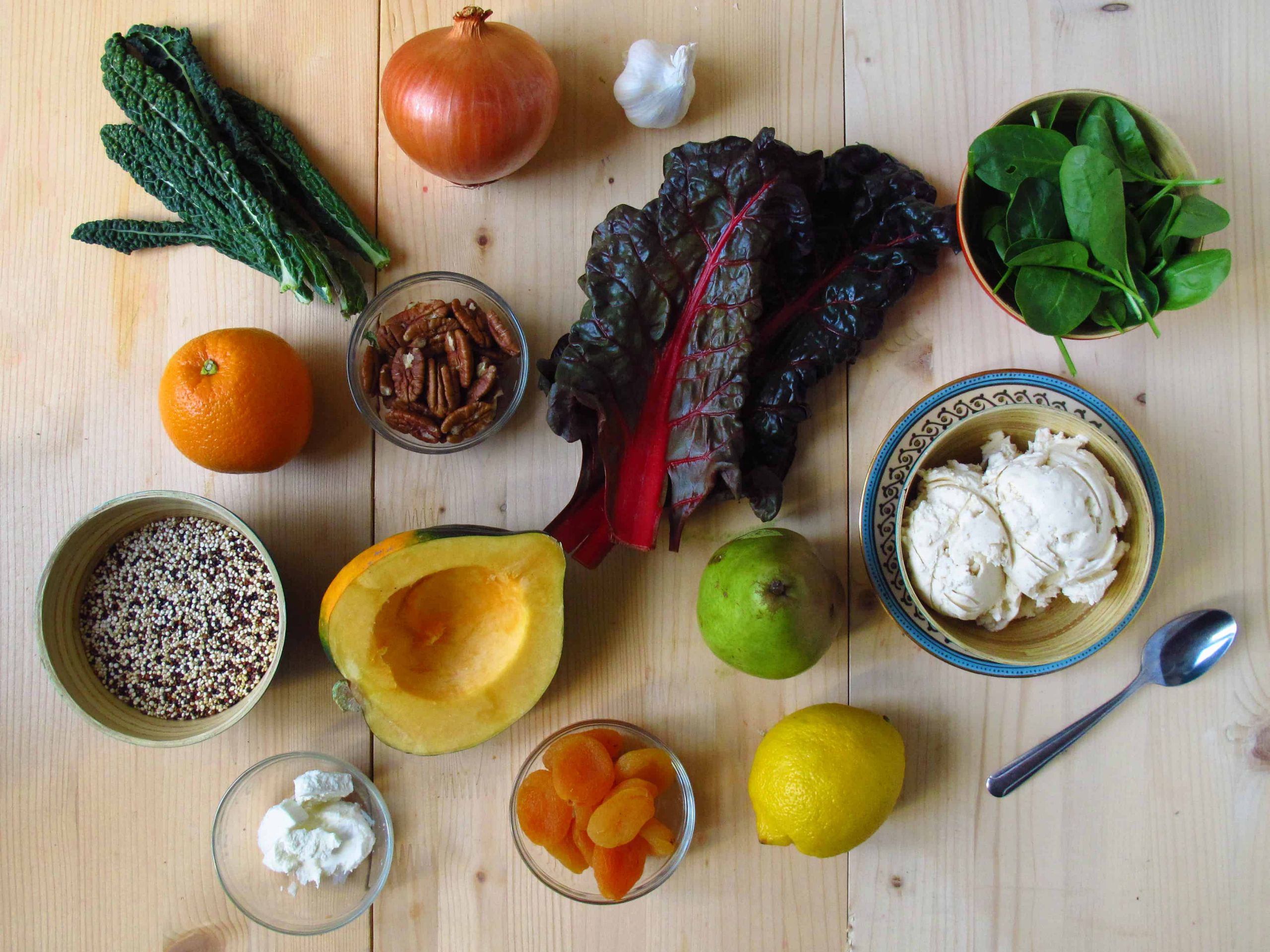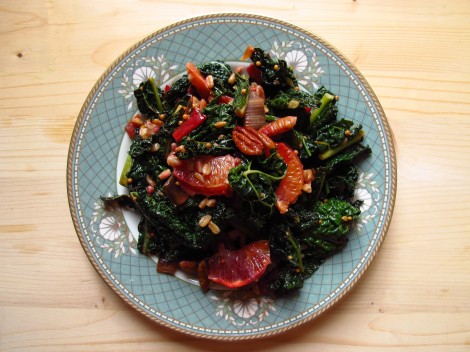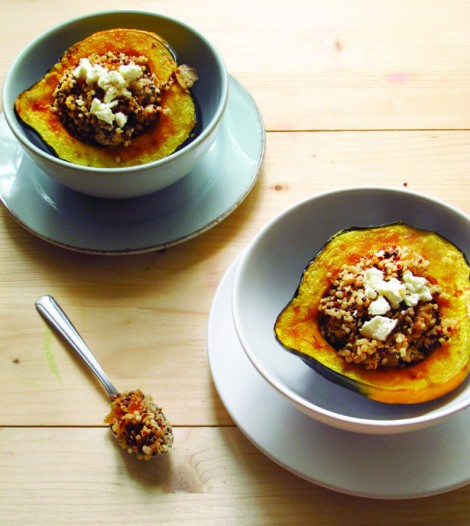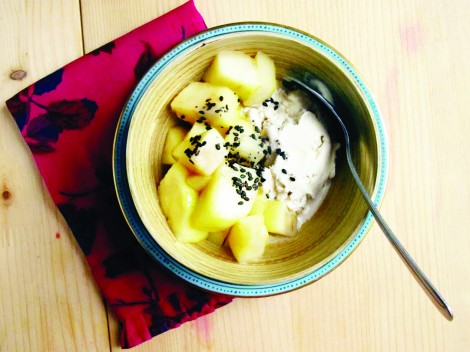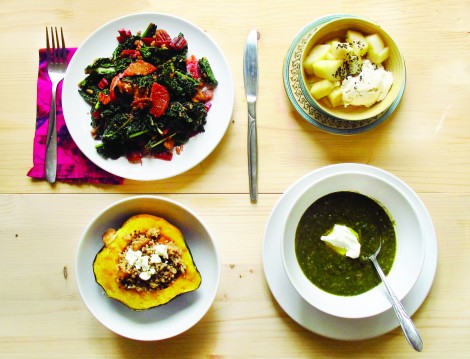By March, many of us have gone on vacation somewhere tropical, and those of us who haven’t just spend copious amounts of time admiring the tans of our peers. Retail stores have long done away with downy coats in favour of pastel hues. Most of us probably feel as though if we ever have to see another beet, potato, or turnip ever again, we’ll cry. But winter produce has stuck by us through the hardest months of the year, and perhaps we owe it a little more respect, even some affection. With this in mind, I crafted four recipes that pay tribute to those last winter beauties, a lovesong of sorts — well, a lovesong that involves roasting, simmering, or frying the beloveds in butter.
Check out where to find the best ingredients downtown:
View Food in a larger map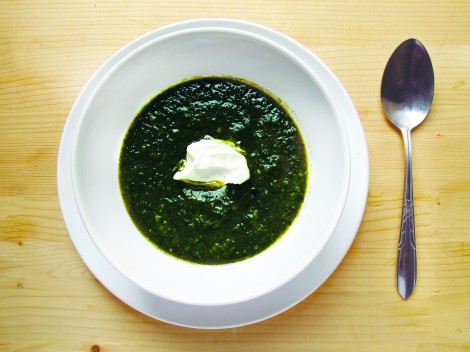
‘Drink Your Veggies’ Green Soup
Serves four as a main or six as an appetizer. Best served with some crusty bread.
Prep time: 15 minutes. Cooking time: 45 minutes.
A few weeks ago, I was listening to an interview with Anna Thomas, the author of soup cookbook Love Soup. She insisted that there’s something about green soups in particular that can help a person feel fantastic, especially because we tend to binge on a lot of junk when we’re in hibernation mode. This soup is an adaptation of the one she described, and it’s everything she promised: rich, comforting, and easily capable of chasing away the winter blues — or the common cold, for that matter.
Ingredients
2 tablespoons extra-virgin olive oil, plus more for garnish
2 large yellow onions, chopped into crescents
2 cloves of garlic, minced
1/4 cup arborio rice
2 bunches green chard (about 6 cups, packed), de-stemmed and roughly chopped
130g container of baby spinach (or about 4 cups packed)
5 cups vegetable broth
1 tablespoon lemon juice, or more to taste
salt & pepper to taste
plain yoghurt for garnish (optional)
Cooking
Heat 2 tablespoons oil in a large saucepan over high heat. Add chopped onions; cook, stirring frequently, until the onions begin to brown, about five minutes. Reduce the heat to low, and cover. Leave to cook, covering the pan again, and stirring occasionally, until the onions are greatly reduced and have a deep caramel colour, 25 to 30 minutes. Side note: while the onions are reducing, they don’t need constant attention, so feel free to prep your greens, check your email, or do your dishes at the same time.
When the onions are caramelized, increase the heat to medium, add the garlic and the 1/4 cup arborio rice to the pan and stir for a minute, taking care not to burn the onions. Add the chard and the 5 cups of broth. Stir for a minute or two while the chard cooks down, then add the spinach. Stir together and bring the mixture to a boil; reduce heat to low, cover, and simmer for 15 minutes.
Allow the soup to cool slightly, then purée until smooth with an immersion blender, a food processor, or a regular blender. Stir in 1 tablespoon of lemon juice, or more to taste. Most broths are quite salty, so you might not need to add any salt, but feel free to do so to taste, plus a few cranks of pepper. Garnish each bowl of soup with a drizzle of olive oil, or an optional dollop of thick, plain yoghurt.
Black kale and blood orange salad with chard and pecans
Serves four as an appetizer, or two as a main.
Prep time: 10 minutes. Cooking time: 15 minutes.
The end of winter is the last time blood oranges are going to be available in-store, and this warm salad is the best way to show them off. The brightness of the citrus is set off by the slight bitterness of the kale and the buttery crunch of the pecans; the mustard dressing helps the whole dish come together beautifully. To make this salad more filling as a main, you could always throw in some cooked brown rice, quinoa, or barley.
Ingredients
2 heads of black kale
stems from 2 bunches of rainbow chard
3 blood oranges
1 cup chopped pecans
1 tablespoon + 2 tablespoons extra-virgin olive oil
1/2 teaspoon salt
1 scant tablespoon apple cider vinegar
1 teaspoon grainy Dijon mustard
1 teaspoon honey or maple syrup
pepper to taste
Cooking
Trim off about one inch from the ends of the kale and discard. Wash and chop the rest into bite-sized pieces, then set aside. Chop the chard stems into 1-inch pieces and set aside as well.
Using a paring knife, cut the rind and pith away from the orange. Peel the orange segments apart over a bowl, so as not to lose too much juice, and set the bowl aside.
Heat a large, dry saucepan or frying pan. Toast the pecans on medium-high heat for 2–3 minutes, stirring constantly and taking care not to burn them. Once toasted, set aside. In the same pan, add one tablespoon of olive oil. On medium-high, sauté the chard stems for 3 minutes, then stir in the kale. Add 1/2 teaspoon of salt. Cook together for 5 minutes, or until the kale reaches the desired tenderness.
Remove from heat, and stir in the blood orange sections and the pecans.
In a jar, mix together the remaining 2 tablespoons of olive oil, the cider vinegar, the mustard, and the honey. Add a few cranks of pepper to your taste, then pour the dressing over the chard and kale. Add the oranges and pecans, and toss. Serve immediately while still warm.
Roasted acorn squash with quinoa stuffing
Serves four as a main.
Prep time: 20 minutes. Cooking time: 35 minutes.
Stuffed and roasted squash is one of the most quintessentially comforting winter foods. But the best thing about this dish is that in addition to looking and tasting fantastic, it’s surprisingly easy to make and can always be modified with what you’ve got on hand. Other than a little chopping, the oven and the stovetop do almost all the work, making you look like a culinary genius.
Ingredients
2 small acorn squashes
1 Tablespoon extra-virgin olive oil
1 cup dried quinoa
2 cups water
2 Tablespoons melted butter
1/2 teaspoon cinnamon
1/4 teaspoon salt
1 cup chopped toasted walnuts, pecans, or almonds
1 cup chopped apricots, dried cranberries or cherries
1 heaping teaspoon harissa (Moroccan chili-based spice paste)
1 small package goat cheese, for garnish
Cooking
Preheat the oven to 400°F. Coat a large Pyrex dish (or two small ones) with about 1/2 a centimetre of water.
Halve the squashes lengthwise (tip to stem) — this task requires a really sharp knife, so please don’t attempt with Ikea knives or anything of the sort. Scrape out the seeds and discard. Using your hands, rub the cut sides of the squash with the tablespoon of olive oil. Place the squash cut-side down on the baking dish, and roast at 400°F for 25–35 minutes, or until the insides are fork-tender.
While the squash is cooking, prepare your stuffing. In a mesh sieve, rinse the quinoa very, very well — if you don’t, it will retain a nasty metallic flavour. Then add it to a large saucepan with 2 cups of water. Bring to a boil, then reduce to a simmer uncovered. Cook, stirring occasionally, for 12–15 minutes, or until the water is gone and the little threads around the seeds have started to pull away slightly.
Add the butter, cinnamon, salt, chopped nuts, harissa, and dried fruit to the quinoa. Mix well.
When the acorn squash is soft, remove from the oven. Turn the broiler onto high, flip the squash so they’re cut-side up, and then return them to the oven and broil for 3 minutes, watching closely to make sure they don’t burn.
Remove the squash halves, plate them, and stuff each of them with the quinoa mixture. Crumble goat cheese overtop for garnish. Serve immediately.
Simple, scrumptious buttered-up pears with vanilla ice cream
Serves one person, but can be multiplied to serve as many as you’d like.
Prep time: 3 minutes. Cooking time: 2 minutes.
For as long as I can remember, dessert has always been my favourite part of a meal. But the thing is, often by the time you’ve cooked a large meal for a crowd (or even just for yourself), it’s hard to find the energy to make a crumble or a cake. This dessert is as simple as it gets, and is the perfect salute to the end of pear season.
Ingredients:
1 pear (or apple, if you prefer)
1 scant Tablespoon of butter
2 pinches of brown sugar
vanilla ice cream
Cooking
Peel the pear, and chop it into one-inch chunks, discarding the core.
In a small frying pan on medium-high heat, melt the butter. Add the chopped pear and sprinkle the brown sugar on top. Fry for 1 or 2 minutes, until the fruit is softened and starting to turn golden-brown. Remove from heat.
Scoop some ice cream into a bowl and top with the pear.
This recipe really doesn’t need anything else, but any of the following would go well as a topping: a drizzle of honey, the zest of 1/2 a lemon, a sprinkling toasted sesame seeds — anything your little heart desires, really.

